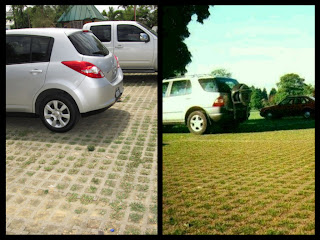
EMA Headquarters on Elizabeth Street Port-of-Spain
Do you think it is ironical that the Environmental
Management Authority of Trinidad and Tobago have carparks that are fully paved?
Well I think it is extremely ironical. The EMA is a
statutory body created by the Government of T&T to address the country’s
environmental problems. They write and enforce laws and regulations to manage
the environment and they also educate the public about environmental issues to
ensure they know what should and shouldn’t be done. So the fact that the EMA
gives guidelines on what is environmentally friendly and what isn’t to citizens
and they themselves don’t think about employing these guidelines makes me
wonder if they really do care about the environment. Eventhough not having
fully paved carparks is not a guideline set by the EMA it is just small
something that they can do to show that they are fully invested in protecting
the environment. It will set the right example for other institutions and
businesses so not giving them an excuse to do something that will disadvantage
the environment.
People may say what is the big deal with this carpark being
concrete. It is small and not causing any damages to. Oh how wrong they will
be. Yes the EMA carpark is just one that is fully paved but you should think
about how much more of these are there all over the country. You may not think
that this will have a big effect but one carpark adds up after a while. The
major problem associated with areas of concrete is it impedes infiltration of
water, which increases surface runoff and may lead to flooding, soil erosion
and water pollution. Concrete also, contributes to urban heat islands forming.
According to National Geographic (2013), an urban heat island is a metropolitan
area that is warmer than the areas surrounding it. Think about Port-of_Spain,
while walking through how hot it usually is and this is reflected more in the
night when it’s supposed to be cooler it is still very hot. Concrete is not the
only cause of this urban heat island but it definitely contributes to it. There
is already so much concrete around the city that all attempts should be made to
decrease it wherever possible even it is by a small amount. Lastly, the
particles from concrete contribute to air pollution. They provide condensation
nuclei for the formation of water droplets and may lead to rainfall that is
frequent and intense which may lead to flooding when coupled with the fact that
the rainwater can’t infiltrate the soil.
Unsustainability does not only affect the environment but
also society. All those effects of concrete don’t only affect the environment
but they have consequences on us. The flooding is a problem for us since it
impedes transportation, destroys property and life and costs governments a lot
of money to fix damages done. The heat provided by the urban heat island is
also a problem since it causes discomfort to citizens and may affect the health
of some. While, heavy rainfall leads to flooding and has the same impacts
mentioned above.
The picture on the left is one of mine and was taken in a carpark across from the St.Clair Hospital in POS.
The one on the right was taken from envirocrete.com to show how the carparks will be when there is grass throughout.
There is a simple solution to this concrete carpark situation and it is seen in the above photo. This solution is grassed pathways grasscrete carparks. This provides a permeable paving solution that is still strong enough to withstand heavy traffic for carparks. It allows water to infiltrate hence preventing flooding, the amount of concrete is less and in small amounts so that there is not a large collective area contributing the urban heat island from carparks and the pollution is less because there are not much loose concrete particles in the small blocks per area. The carparks should have the concrete not only for our connivance but also to ensure that cars do not trample upon the underlying soil and people and hence causing compaction. Compaction will result in the same flooding problems as fully paved carparks because the amount of pore spaces in the soil (stores water) will be reduced and therefore infiltration will also be reduced since the soil cannot store the water.
Grassed pathways are not the solution to all the
environmental and social problems listed above because there are other factors
contributing. But they are the stepping-stones towards solving those problems.
“Corruption and
hypocrisy ought not to be inevitable products of democracy, as they undoubtedly
are today.” By Mahatma Gandhi
This quote shows
that hypocrisy is present in democracy which is represented in my piece where
the EMA is laying out environmental laws and regulations but not really
attempting to achieve sustainability anyway they can. Hypocrisy is present
today as the quote says.
“Hypocrisy in
anything whatever may deceive the cleverest and most penetrating man, but the
least wide-awake of children recognizes it, and is revolted by it, however
ingeniously it may be disguised.” By Leo Nicolaevich Tolsto
What does the above two quotes mean to you?
Can you relate it to what is being said in the above piece
and what the EMA is doing?
References:
Environmental Management Authority. 2011. http://www.ema.co.tt/cms/
Grass Concrete. 2012. GrassCrete Carparks. Isle
Communications. http://www.grasscrete.com/docs/news/view_story.asp?id=60
National Geographic Education Beta. 2013. Urban Heat Island.
http://education.nationalgeographic.com/education/encyclopedia/urban-heat-island/?ar_a=1
Waugh, David. 2002.
Geography: An Integrated Approach. Nelson. United Kingdom.


